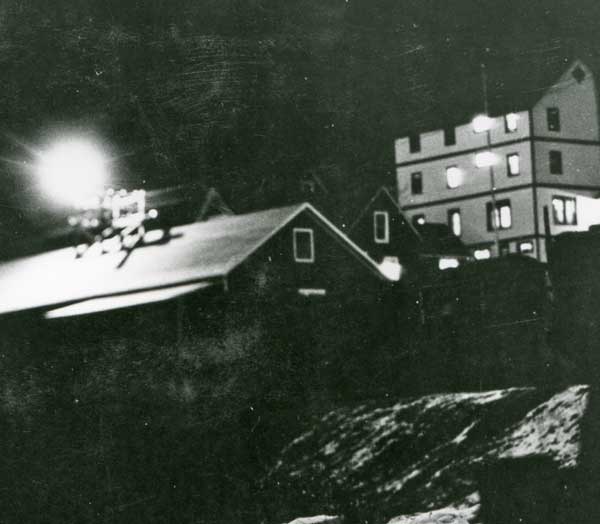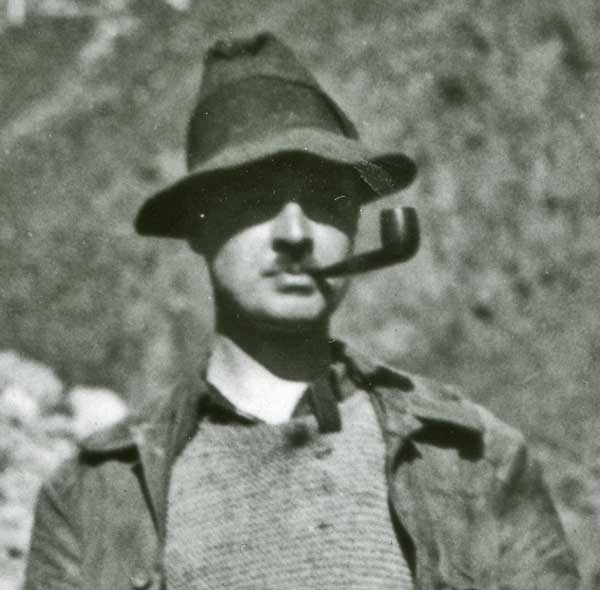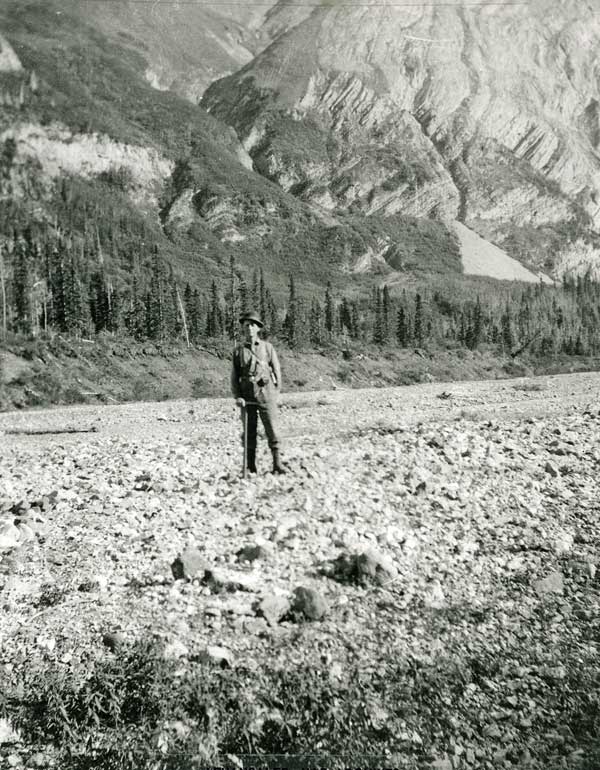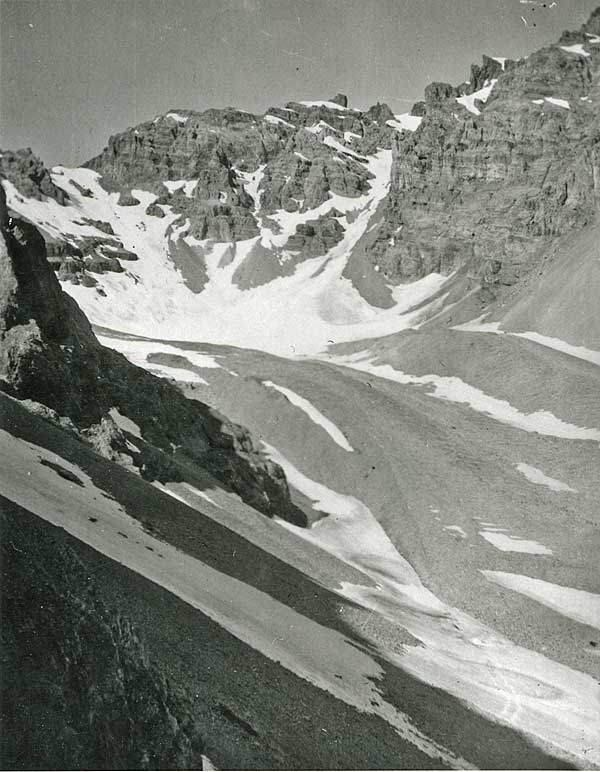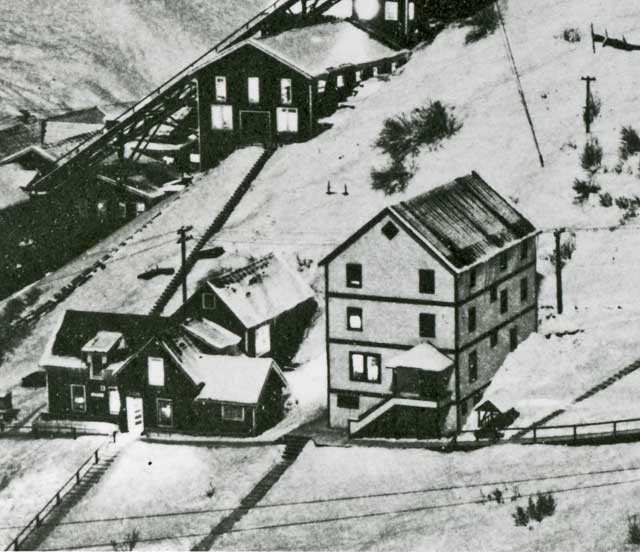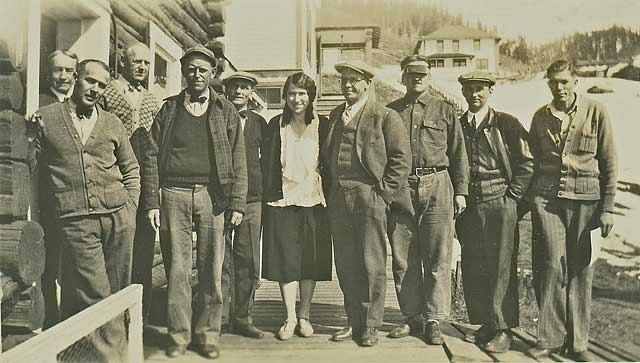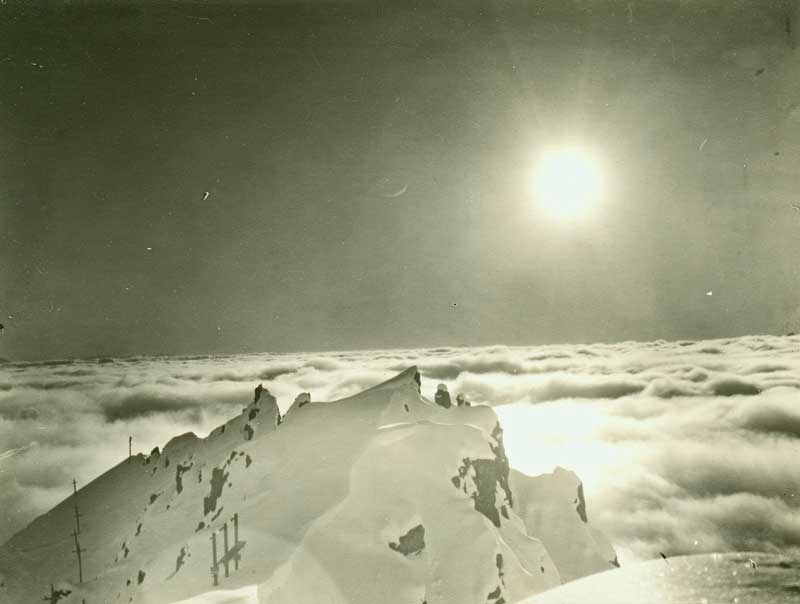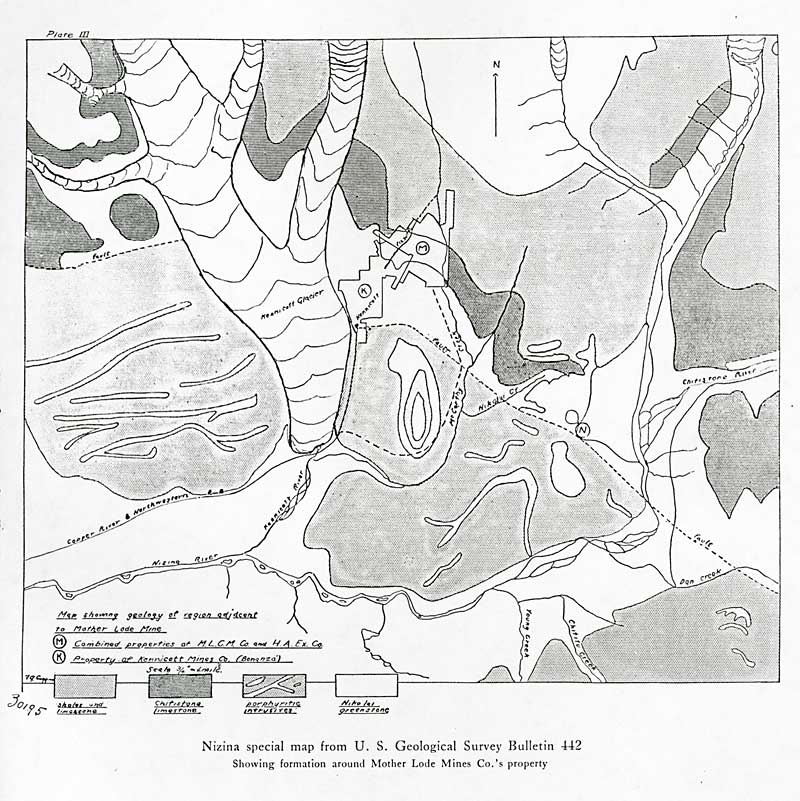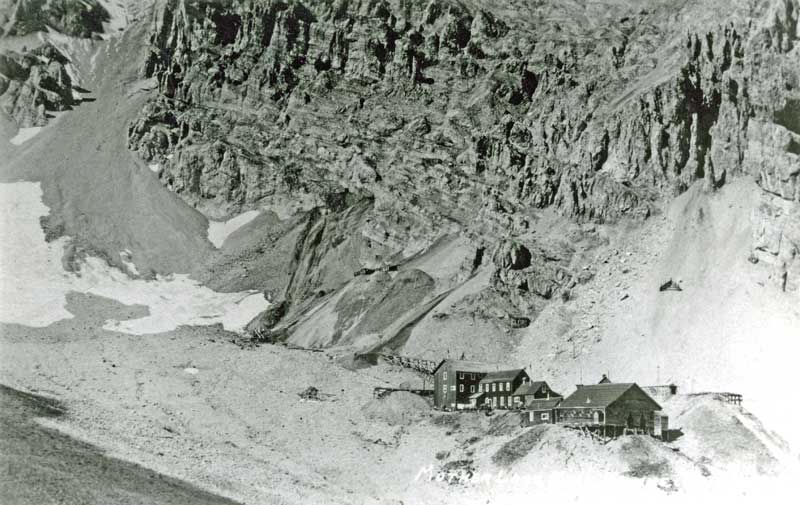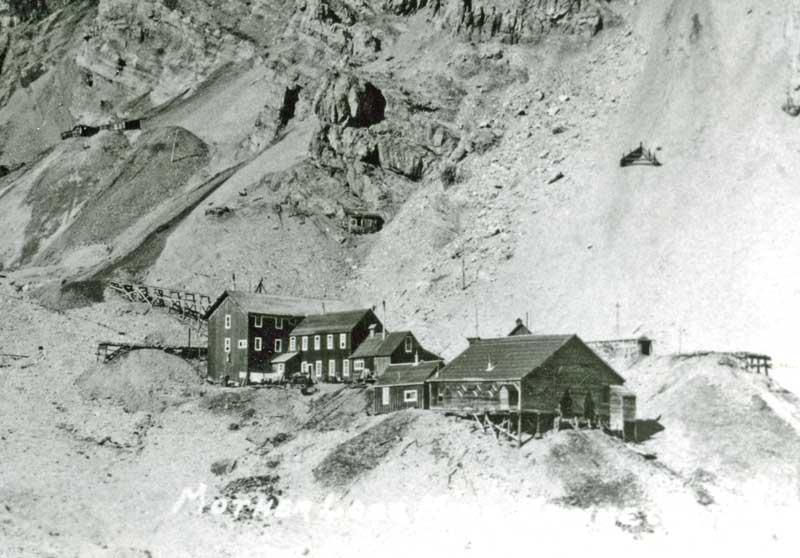Legacy of the Chief, Pt 1, Ch 46: "Frank's Thanksgiving Letter-1926" |
click on picture for larger image: some of these images appear in the book for this chapter. |
Chapters from the historic novel "Legacy of the Chief," by Ronald Simpson, and other items mostly related to the historic background of the Ahtnas in the context of Kennecott Copper & its Copper River & Northwestern Railway.
10 February 2011
Ch 46, Pt 1: "Frank's Thanksgiving Letter"
Chapter 45: "The Marvelous Assignment"
The weather pattern was similar to one which had occurred nine years before that forced the end of old Mother Lode company. There had been a steady build-up of snow in the higher elevations as storm after storm dumped its load over Bonanza Ridge. Chief Engineer Richelsen had recommended that Kennecott permanently close the Mother Lode upper camp due to the ongoing danger of avalanches. Bill Douglass concurred because production at the Mother Lode was declining and the Mother Lode miners could easily be housed at the Bonanza camp. Indeed it made more sense, given the new arrangement of crosscut tunnels at the 800 and 1,250 levels, to house both the Bonanza and Mother Lode crews at Bonanza upper camp, which could bed 124, which was well above what was needed in 1926. It was a relatively fast ride down that Bonanza 30 degree incline shaft to the Mother Lode workings which began at the 1257 cross-cut tunnel. The cross-cut was located near the bottom of the Bonanza incline shaft. The 1257 cross-cut was a major haulage tunnel that ended at the top of the Mother Lode incline shaft. At that point there was easy access to the 1250, 1400 and 1600 levels that were under development by 1922. The Bonanza-Mother Lode was a single vein, extending from the top of the Bonanza to a point well inside the Mother Lode. The mines were contiguous, lying along the same thirty-degree plane. Even though the mines were separated by a line on a map and were headed by different corporations, they were in reality a single mine with the main adit and camp being the Bonanza. Every underground working from Erie to Mother Lode was connected except the Marvelous tunnels. The Marvelous was the original Mother Lode. The workings had been discontinued in 1918 as unimportant. In late 1926 the time finally arrived when they would be reopened to ensure that all possibilities of large ore extensions had been thoroughly eliminated before the area was completely ,abandoned.
The reason for the location Marvelous vein was a mystery. Except for the Slurry vein in the Jumbo workings, all of the ore bodies were found fifty to seventy-five feet above the contact zone that separated the unproductive Nicolai greenstone from the ore-bearing Chitistone limestone. The Marvelous vein had assay reports showing seventy percent pure copper, yet it was hundreds of feet above the contact zone. It failed to fit the ore profile, but there it was anyway. When Kennecott took over the Mother Lode workings in 1918, it deemed the Marvelous a fluke and ordered the work there discontinued. While the Marvelous was the original showing and the only copper vein exploited by the old Mother Lode company, the Kennecott engineers realized that the real Mother Lode of copper ore had to exist in a direct line with the Bonanza contact zone. Wes Dunkle projected a large orebody just beyond the Bonanza vein. He was quickly proved correct when the Kennecott miners encountered the fabulously rich 1252 stope in August of 1918, only months after Mother Lode was absorbed by Kennecott. With the projected end of all the copper mines in sight, it was time to examine the remote possibility that an orebody could run from high up the Mother Lode Gulch and continue well into the adjacent Marvelous Gulch to the northeast along the same strike as the other veins, but well above the main vein. It would require following the existing Marvelous workings and mining them out to expose all the ore at that level. The main reason the Marvelous had been left alone for so long was its isolated position. It would have to be connected to the rest of the mine system by running a raise from the Bonanza-Mother Lode 800 level to the Marvelous 600 level. It would also be necessary to extend the Mother Lodge vertical shaft upward to meet the 600 level. The 800 level is one of the first of two main crosscuts that allowed haulage from the Mother Lode workings to the Bonanza incline. To save time and to avoid the cost of extensive tunneling in order to properly connect the Marvelous to the main system, the engineers concluded that it made more sense to reoccupy the old camp, located 5,200 feet above sea level on the McCarthy Creek side, at the end of the 800 cross-cut, also known as the Rhodes tunnel. The old camp had a jig-back tram which facilitated travel to the 600 level adit, which was the base level for the upper Marvelous workings. The men would be able to readily access these workings by staying at the old camp while dropping the ore down the new chute that dropped into the Rhodes tunnel. The upper Marvelous was relatively close to the top of the ridge, resulting in considerable water seepage into the upper workings--a problem that was common to the upper levels of Bonanza and Jumbo. The problem at Marvelous was more severe because it was considerably closer to the surface. There is much less ridge above those workings than anywhere else. The Jumbo adit was a thousand feet below the top of Castle Rock, just as the Bonanza workings were about a thousand feet below the top of Bonanza Peak. The Marvelous, at one point was only a hundred feet or less from the top of the ridge. This was the point where the ridge separating the two gulches dipped steeply toward the McCarthy Creek canyon. The snow tended to accumulate to great levels from the top of Bonanza Peak on down to the area just above Mother Lode upper camp. The camp was in a narrow gulch with a steep ridge to the north and a glacial cirque to the west. The proximity of these two high points to the camp left the Mother Lode in constant danger of inundation by avalanche. The meeting among all the engineers to discuss the Marvelous took place late in 1926 in the map room. “I am opposed to reopening that Marvelous area, especially if it also means opening the upper Mother Lode camp. If we must do it, we need to extend the tunnel system so the men can easily access it from Bonanza.” “We are well aware of your strong opposition, Walt. What about you, Melvin?” “I have to admit that Walt could be right. That is a very dangerous area, especially during the season we’re considering for the exploratory operation. The seepage problem is bad enough, but that avalanche danger, especially with the heavy snowfall so far this winter, is at least as bad as it was when we first acquired Mother Lode. I sure would not want to be the resident engineer in charge of that project.” Bill looked around the table. The concern in the eyes of most all the engineers was difficult to mistake for simple worry. It verged on genuine alarm. “Your concerns are noted, but I have the orders right here from my bosses, Mr. Nieding and, more importantly, Mr. Stannard. He wants the area mined and the exploration completed so we can permanently close Marvelous out. And he wants it done as soon as possible. I understand that he’s been pressured from the stockholders of Mother Lode Coalitions Company. Some of them are large investors of great power who are not at all happy with their returns for 1925 and 1926.” “They were all stockholders when the Marvelous was being mined. Now they want the work finished. They seem to think that there really is a large orebody there which would justify extending our tunnel system in that direction.” “Damned that Bateman,” someone was heard to mutter. “Well, I’d like to think so myself. After all, the prospects for Kennecott have not looked too promising lately. “From the very beginning we’ve built our reputation on our ability to face and overcome adversity. We’re still considered the miracle workers of the copper mining world. Every problem we’ve ever faced has been overcome. The profits for both Kennecott and Mother Lode Coalitions Company reflect that.” “So now it’s come to this, Bill. Is it profits ahead of safety? Is is the considered opinion of the expert engineers against the hopeful wishes of a few greedy investors who’ve already long since made their fortunes? What makes those stockholders experts on Alaska mining, anyway? Not a one of us really believes there’s anything to that Marvelous nonsense. We called it a freak occurrence then and shut it down. It’s like the Nicolai Prospect--all show and no substance. Why risk the men and so much of our resources for something none of us believe in?” Bill leaned back on one of the office chairs rolled into the room for the conference. He lit his pipe and looked out the west-facing windows to the glacier. “Walt, you’re my right-hand man. You’ve been here as long as I have and we’ve all learned to respect your engineering skills. But this is no longer a simple matter of our opinion as to whether the ore is there. These men pay our way. They could close us tomorrow and never miss the place. They haven’t given me any choice. “It’s no longer a matter of whether or not we proceed. It’s how we go about it.” “Then we better plan carefully for safety.” “Even that’s a problem. Charles Earl and C.T. Ulrich want us to close the area out as soon as possible. They’re thinking they can finish mining Mother Lode and get out with a large profit.” “That’s not possible. Not getting out quickly, anyway.” “I know, Melvin. Realistically we’re years away from mining out the property. But this time our expert opinion doesn’t count. So we need an engineer to head the Marvelous Project. I’m giving it a special priority, which means he’ll have the complete resources I have at my disposal, especially the help of all of us.” “Russell, you’re next in line. Do you want this assignment?” Russell Belvedere was known for his willingness to speak out when most of the engineers would say nothing. He had an irreverent streak in him which ran deep, but he was also extremely dedicated to his work and held the respect of his fellow engineers. He was currently assigned to the Jumbo along with Frank Buckner, the junior engineer. They were working on the details for a retreat plan in advance of closing the Jumbo mine down. “Thank you, Mr. Douglass, but I believe that this is a opportunity we owe to Frank here, who has been at the mines three years without having a command assignment like this one. I already have the Jumbo, at least when Mel is elsewhere. I suggest that we give this job to Mr. Buckner.” Russell did not want Marvelous any more than did Melvin Smith, who probably should have been given it due to his level of expertise. All the engineers turned toward Frank, who looked, in his engaging boyish manner, completely surprised and overwhelmed. “Sir, I’ve been ready to take on this or any other command assignment from the moment I arrived here. If none of my seniors wants the job, I’ll be more than willing to take it.” The other engineers nodded their agreement, settling the matter, though Walter Richelsen felt uneasy about the entire process. He even felt a little guilty. This is no job for a junior engineer. That’s a tough one up there. I should do it, I suppose, but Gladys would have a fit. He considered the youth and inexperience of Frank Buckner and almost stood up to volunteer himself instead. But he quickly thought better of it, especially with the disapproving image of Gladys on his mind. He stayed put. The meeting went on as the engineers considered the difficulties with Marvelous in the springtime. The coldest part of the winter time was out of the question because the jig-back tram was too cold to operate then, and because the upper workings would also be too cold due to the proximity to the surface. It would also likely be heavily frosted, creating yet another set of difficult and hazardous working conditions. Furthermore, the upper camp could not be placed back on line until warmer weather moved in without great cost and difficulty. The engineers anticipated workable temperatures by the end of March. The greatest problem then would be the overhead snow which would begin melting into the workings during the warmer daytime hours. That problem would be partly alleviated by running the crew only at night during the freezing temperatures. For by mid-April when operations should be well underway, the daytime warmth would undoubtedly cause some unavoidable water run-off problems into the upper areas, so everything had to be completed in that upper area on a very tight schedule. “I’m assigning a crew of eighteen, and picking the Erie foreman, Eldon Johnson, to head the special crew. He’s well experienced for this sort of operation.” Douglass was looking straight at Frank Buckner. “You’ll be on your own out there, so you’ll have your own cook and waiter. They’ll have to come from the staff already at Bonanza. We’ll move them to the Mother Lode to serve your crew and tend to the barracks facilities. It’s good that you have some practical experience with boilers and electric motors. You’ll need it out there. Frank, you’ll have to see to the safe operation of the jig-back tram motor and the boiler which will heat the camp. Fortunately, the boiler there is a new one, as we just installed it in 1920 when the original proved too small and unreliable for our needs. “The power already runs through to there by way of the 800 crosscut, but the boiler fuel will have to be trammed up McCarthy Creek this winter and then hoisted up the aerial tram at thirteen mile. That means you will also have to see to the operation of the thirty-five horse tram motor from the days of the old company. We rebuilt the entire aerial tram system in 1918 after the last avalanche destroyed most of it. We’ll check it again, of course, but the tram should be in good repair.” “This is beginning to sound like a major operation.” “In a way it is. You get your own camp, Frank. That’s part of it. It also means that a lot of old equipment that hasn’t been used in years has to be tested. “We’ll send the coal for the cook stove up on the same winter sleds with the bunker fuel. We’ll have to clear the McCarthy trail past Green Butte since road hasn’t been used for some time, but that should present no unusual problem. The road to Green Butte remains open, even though that mine stopped production last year. “In conclusion, we’ll take whatever resources we have and use it all to full advantage.” Frank looked at Bill Douglass, Walter Richelsen, Mel Smith, Russell Belvedere and the others and then leaned back on his swivel stool contemplating this. “I’ve no problem making any of that equipment work. I’ve done it enough times before in Montana and even as a boy in Wyoming. But I hear a sound of reluctance to fully back up the Marvelous operation in the tone of your voice. That bothers me.” “I’m sorry, I didn’t mean it to sound that way, ” Douglass replied. “I guess it’s just the over-all tone here since Stephen Birch announced to all of us that we were no longer high on the priority list. Actually, we are not on any priority list. We are essentially on our own to finish this project economically and without extra funds. That’s just the reality of it.” “Frank, you’ll have to ask for volunteers for head cook and waiter-bull-cook. I’m leaving it up to Eldon Johnson, to put together a mining crew. Because of the nature of the work, the crew will be carefully selected. This is not, by any means, an easy assignment, but it is likewise a challenging opportunity which will mean a strong recommendation from me for almost anything you want professionally once you’ve successfully completed this assignment.”
It was snowing heavily outside the office. The top of the mill could no longer be seen, though it was well-lit. Production was still heavy enough to require a night shift at the mill and tram terminal even in mid-winter. With the meeting dismissed, Frank walked with Russell, one of the other unaccompanied engineers up to the three-story staff house, just uphill from the office. They walked up the wide steps onto the covered porch where a door with leaded glass marked the inside stairwell landing. At this first level, which was actually one floor above the sidewalk below, were the two common meeting areas. There were also two guest rooms and two complete bathrooms. On the second and third levels were six rooms each with two full-baths common to each floor. The top level was reserved for the women, including three teachers, two nurses and the stenographer. On the second level lived Russell, Frank and four other engineers. The two most senior engineers, including Melvin Smith, lived on the main level. The others were accompanied by their wives and children. They lived in the cottages. Bill Douglass lived in the house just uphill from the staff house with his four children, wife and a nanny. No one lived in the manager’s house at the top of the walkway since Bert Neiding moved to Seattle in 1924. Frank opened the glass-top door and let Russell enter first. Russell excused himself and headed upstairs to his room. Frank needed time to think. He headed for the living room adjacent to the entryway. This warm corner room overlooked the office. From there, Frank could see Bill Douglass in an animated conversation with Walt Richelsen outside in the blowing snow, where they were just leaving the office. Frank sat back deep into the leather couch. The Regulator clock showed the time as nearly two-thirty in the morning. It had been a very long meeting. Frank began to have doubts about what was about to happen. Am I really up to this assignment? Can I handle this one alone? Why did Walt seem so uneasy about Mother Lode. What was that heated discussion with the superintendent out there in the blowing snow over? Melvin walked in on the way to his room down the hallway on this main floor. He looked at Frank, but only smiled weakly and nodded silently before disappearing down the hallway toward his room. Frank pulled himself out of the soft couch and headed upstairs toward his room in this comfortably warm and even cheerful staff house. Outside the wind had picked up. It was snowing even more heavily, gusting and even drifting. By morning the snow would lie heavily over the entire Kennecott and McCarthy area. The storm would continue, stopping even the train from its normal arrival. It would be a winter no one could forget.
|
Chapter 44: "Kennecott Goes into Subtle Decline," Pt 2
Life at Kennecott went on as usual, but development of the mill site ended in 1923 with the addition of the water flotation plant to enhance an enlarged ammonia treatment system. It was a final piece in a master plan developed by E.T. Stannard years before to effectively process the carbonate ore, which could not be mechanically separated. The installation of these two complementary processes marked a huge step foreword in copper milling efficiency. The final great improvement was completed at the height of production, one year before Stephen Birch’s final visit. Except for the re-building of the destroyed power plant and the addition to the hospital, the mill addition was the last major work ever done at Kennecott.
Up on the ridge, Superintendent Douglass had been developing the Glacier Mine. It was separate from the underground mine system, being primarily an open-pit mine. In 1920 the company built the 5,000-foot-long tram, extending from Jumbo tram station no. three in an easterly direction up to the rock glacier. The mine was a rock glacier consisting of ice mixed with talus containing dolomite limestone and the eroded part of the original Bonanza ore outcropping. Until 1920 the company had been too busy developing high-grade ore veins. Finally the company turned its attention to the surface ore found not only at the rock glacier, but also on the extensive Bonanza talus slide directly below the upper camp.
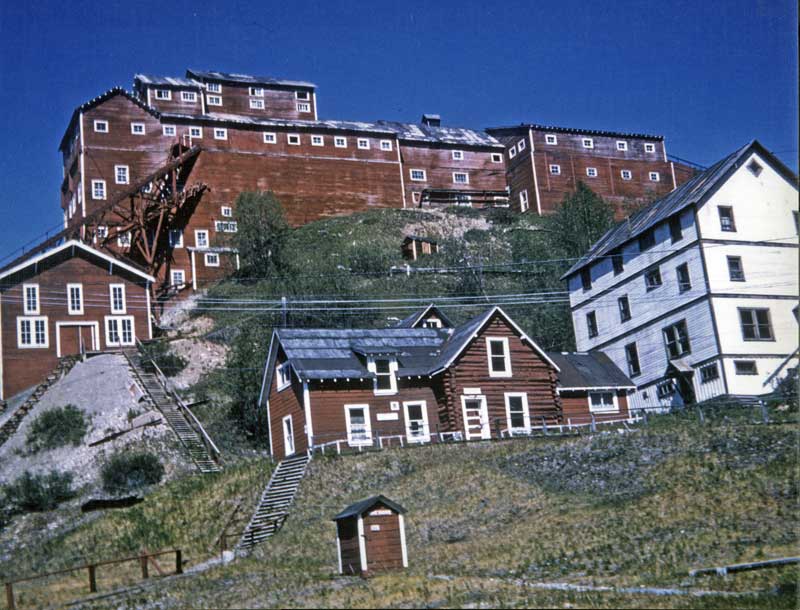 |
| The abandoned mill in 1950 --Charlie Ricci photo |
The Glacier Mine and the Bonanza slide ore was heavily mixed with waste rock and was too lean to process as long as there was an abundant supply of high-grade copper. But those days were soon over. The average content of the high grade ore slipped from seventy percent to about fifty percent by the early 1920s.
Thus the extraction of ores of lesser values began. The expansion of the ammonia leaching plant and the building of the water flotation system allowed for the expanded processing of these lower-value carbonate ores, extending the life of the mine by several years. Yet in the end, even the ammonia leaching plant became too expensive to operate. By then all resources had been placed into the extraction of the remaining floors and pillars--the last of the high-grade ore along the fifty-two miles of underground workings within Bonanza Ridge.
Even while Kennecott committed more money into the milling process to extend the life of the mines, the massive rich ore stopes had already been largely cleaned out. The Bonanza and Jumbo mines were considered to be mature mines. Most of the effort in these areas was concentrated on the extraction of the rich pillars still left in place to keep each level intact. The process of pillar extraction was necessarily left to the the very end, as the removal of pillars meant the collapse of various levels. There were about a dozen levels in Jumbo and Bonanza that would be affected by this process. This final step could only be initiated once the engineers determined that there was nothing left to mine. A carefully laid-out plan of retreat specified the order of removal of the ore pillars so that mining could be conducted safely and without mixing high amounts of useless waste ore in with the remaining high-grade ore of the pillars and floors.
Finally, Alan Bateman marked out two large areas for exploratory drilling, drifting and cross-cutting in the late 1920s. This was in the large block of unexplored ground between the Jumbo and the Erie.
With the opening of the Jumbo 1500 level crosscut tunnel connecting Erie to Jumbo, four small ore bodies were discovered. This ore, along with that from the northerly Erie Mine, was hauled up the Jumbo incline so it could be transported to the mill on the Jumbo tram. Although Erie had produced ore in small quantities since 1916, this was the first time that full production was possible. The Erie barracks was expanded in 1924 to take advantage of this development. Most of the new exploration from the Jumbo was now directed toward Erie. A long crosscut parallel to the 1,500 level Jumbo one was completed in 1930 from the 2,600 level of Mother Lode to the 1,050 level of Erie, crossing the 2,500 level of Jumbo, which became the deepest point of the Jumbo thirty-degree incline. Much to the frustration of the engineers, the entire four-mile run proved barren, finally proving that the lower levels of the copper ore veins had already been reached. Alan Bateman then convinced Kennecott to run another exploratory cross-cut tunnel northward from the 700 level of the Jumbo incline toward Erie--well above the main cross-cut. Bateman was convinced that ore had to lie at this level, but his project was quietly abandoned when the tunnel encountered difficulties as it approached the overhead Amazon Glacier in 1937. It was Alan Bateman’s last hope and his greatest disappointment. Cross-cut 710 North was the last long exploratory tunnel ever run by Kennecott.
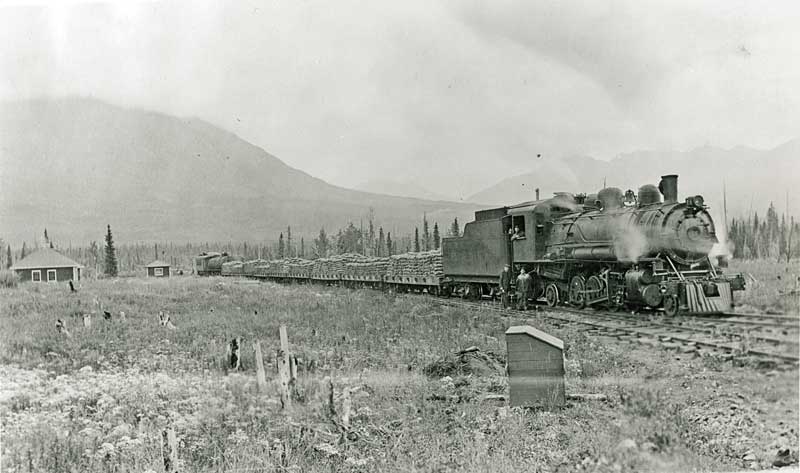 |
| A CRNW ore train passes Chokosna in the late 1930s |
On the Bonanza side, all the activity remained centered at Mother Lode, which was the deep extension of the Bonanza-Mother Lode orebody. The Bonanza incline which led to the 1,257 crosscut over to the Mother Lode incline remained in heavy use because it was the primary route for tramming the Mother Lode ore to the surface. The 800 level cross-cut, 450 feet above the newer cross-cut that connected directly into the Mother Lode incline shaft was last used to complete the exploration of the Marvelous ore bodies in 1927. The upper 1,200 vertical feet in the Bonanza was almost completely absent of activity while the Mother Lode 1,252 stope and other Mother Lode stopes adjacent to and below the Bonanza property continued to operate at a furious pace.
Although the engineers had concluded that the likelihood of finding additional rich ore bodies was remote, the company continued to drive the Mother Lode incline deeper, extending it well beyond the 1,600 level where the last major orebody had been located. Even with the failure of the 2,500 level cross-cut to produce new ore bodies, the engineers chose to continue the Mother Lode incline all the way to the 2,800 level. Nothing of interest was found anywhere in the last thousand vertical feet. That was the end of it.
As underground exploration expanded, production rapidly declined. The slump began to be reflected in the operation of the railroad. The CRNW quietly dropped daily service in the mid-1920s. Near-impossible conditions produced maintenance problems far exceeding anything encountered in the States. It earned the CR and NW the nickname “Can’t Run and Never Will.” Lapses in the schedule had long been accepted as normal. The ending of the daily train service went almost unnoticed. Soon the typical line of thirty-five flat cars became thirty, then twenty. A run of thirty cars every other day became the norm, then even that diminished sharply as the 1920s came to an end.
In 1924 the two-story Dwyers Inn at Strelna burned down, never to be replaced. Strelna, once considered the future hub for a mining district which contained the promising North Midas and Elliot-Hubbard Mines on the upper Kuskulana, was relegated to just another whistle-stop. These mines and most the others closed by the end of the 1920s. Early proposals to run branch lines up the Kuskulana and McCarthy Creek never even made the drawing board.
Traffic through McCarthy had begun to slow as the Chisana gold boom quickly became a bust. The other Nizina gold field operations continued, but they employed relatively few men. The Green Butte closed in 1925, and the road up McCarthy Creek was abandoned. McCarthy awaited an end that would shared with Kennecott. Chisana, Strelna, Chokosna, Chitina and Bremner never developed into the mining hubs that once seemed inevitable.
Traffic through Chitina had slowed to a crawl as freight and passengers from the Alaska Steamship Line developed a preference for Seward over Cordova, and for the new Alaska Railroad over the Copper River and Northwestern, which ended at Chitina instead of Fairbanks. Passengers arriving there found a rough wagon trail of 350 more miles if they wanted to reach Fairbanks. The surveyed route extending the Cordova Mainline from Chitina to Fairbanks became a historic footnote in 1914. The Hotel Chitina, which had been optimistically expanded to seventy rooms by 1917, became an early relic of a boom that had busted. All that remained was the business of the Kennecott copper mine itself. In 1924 it was not yet evident to many that a precipitous decline culminating in a full shut down had already begun.
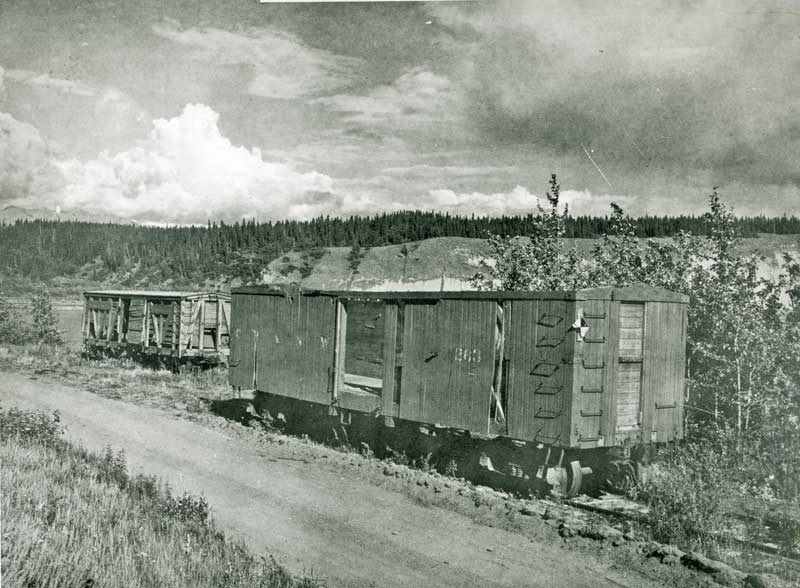 |
| Abandoned boxcars on Kotsina Hill east of Chitina --UAF Archives Continue with Chapter 45: "The Marvelous Assignment" |
Chapter 44: "Kennecott Goes into Subtle Decline," Pt 1
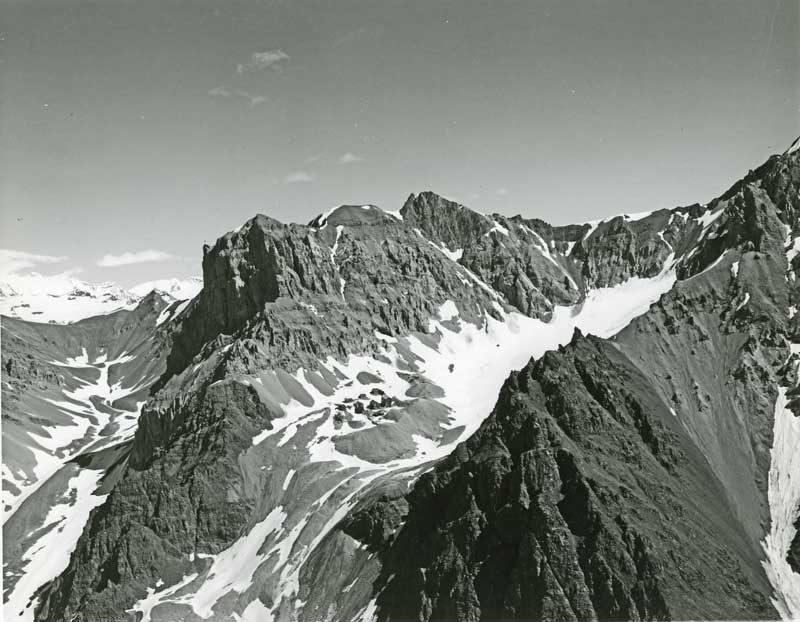 |
| Abandoned Jumbo Mine viewed from the air in 1955 --AMHA, Ward Wells Collection |
Subtle changes were taking place at Kennecott, which were obvious only to the engineers and their managers in the far away offices in downtown Seattle and at 120 Broadway in New York. Kennecott President Stephen Birch visited Kennecott for the last time in 1924 to evaluate the future of the Bonanza and the other mines. The inescapable conclusion was that all the major ore bodies had already been discovered and that the mine was now operating off of rapidly shrinking reserves. Even at that, the ore bodies were so extensive that the decline would not be obvious for years. Some never saw it at all. The consulting engineers estimated the remaining tonnage would take another eight years to extract, given a continued high rate of production.
From 1916 through 1925 the production was such that an ore train was required to operate six days a week, pulling at least thirty ore cars on each consist. The conditions under which the railroad had to operate required very high maintenance, but even so there were many weeks out of each year when the railway was inoperable. In most cases this was either due to extreme snow-drifting along the first hundred miles of the railroad or because the crossing at Chitina had gone out. The line was subject to frequent wash-outs, collapse of trestles and rail beds, avalanches, and problems with the tunnels.
The constant demand on the railroad had taken its toll on the track bed, the trestles and on aging rolling stock. The CRNW simply could not continue to operate as it had in the past without major investments to upgrade the system. Stephen Birch had already ruled out this possibility.
Had Birch and Stannard had their way, the mine would have closed by 1930 when they shut down the Beatson and Girdwood Mines on LaTouche Island. However, Alan Bateman, the senior mining consultant who replaced Wesley Dunkle, convinced the company not to purse a high speed withdrawal. Bateman preferred a twelve-year plan of retreat, not because the company was operating an aging railroad, but because he wanted more time for additional exploration. The consulting engineer wanted to be certain that every possibility of finding new ore bodies had been thoroughly exhausted.
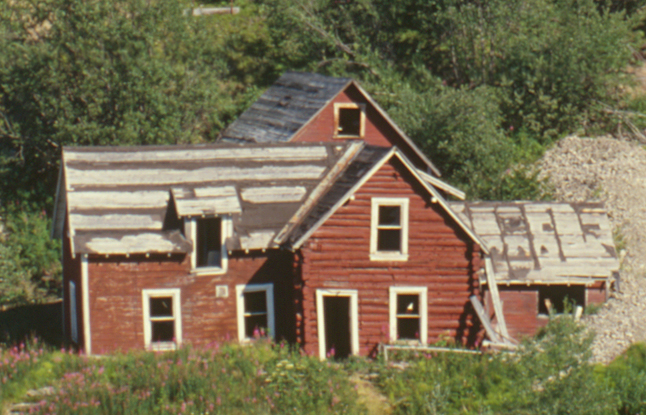 |
| The abandoned Kennecott general office in the ghost town of Kennecott in 1981 -Historic American Engineering Record |
In the end, it all became a matter of weighing the cost of continuing the operation of an aging and obsolete railroad system against the cost of extending the life span of the Bonanza, Jumbo and Mother Lode mines.
The Copper River and Northwestern Railway was never completed as intended. The temporary trestles made up nearly fifteen percent of the track grade from Cordova to Chitina. It remained that way for the twenty-seven years of railroad operation. Permanent steel bridges, contemplated to replace the larger wooden trestles, including the four-span Copper River crossing at Chitina, existed only as an engineering drawings, never to be built.
All the short-term fixes of those early years became permanent when it became apparent that the CRNW would never be anything more than a large mining railroad. Kennecott, the owner of the CRNW, decided it made more sense to maintain their aging trestles and other obsolete railroad features than to replace them. Unfortunately, no preservatives were used in the original trestle bents or the wooden ties. The company operated almost on a year-by-year basis, refusing to invest more than the absolute minimum amount of money required into their antiquated and increasingly inadequate system.
Large sections of the railway ran over old glacial remnants that were subject to severe melting, similar to the vast expanses of permafrost. None of the engineers understood how to build in such country. The most severe permafrost conditions existed around Strelna, but the problem extended along most of the Chitina Local branch from Chitina to Kennecott.
The snowsheds along Abercrombie contained heavy timber construction that deflected enormous snow loads, but these were eventually destroyed by the sheer weight of the overburden. They were not replaced after their destruction by heavy snows in 1931, the last year of winter railway service.
Railroad ties and trestle bents were constantly being replaced, while hundreds of thousands of cubic yards of gravel were dumped to stabilize other sections of the remote line.
No one knew how long the system could be kept patched together. The line was only one of a handful of sub-arctic railroads in existence. The engineers could only present expensive suggestions to fix on-going problems. What was clear was that it would always take up to 250 men to run the unproductive, money-losing railroad--about the same number required to run all the Kennecott mines at high production levels.
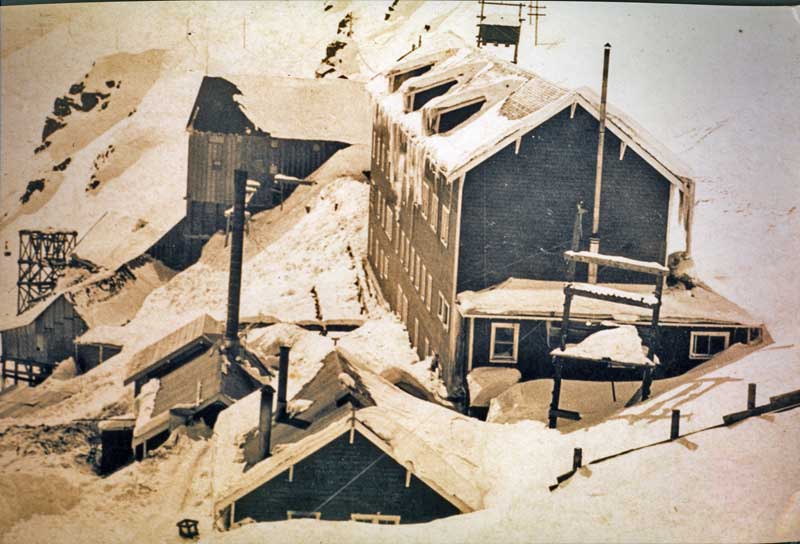 |
| Bonanza Mine --Simpson files |
It was the lingering possibility of finding additional rich ore which finally won out. Birch reluctantly opted for an extended plan of mining retreat in 1925. Because of this decision, the gradual exhaustion of the mines would go unnoticed to all but a few. A subtle withdrawal served the interests of Kennecott, who did not want to be left at the mercy of hostile labor elements who might seize on the opportunity to press for huge concessions. E.T.Stannard was prepared to shut down immediately and permanently if faced with a massive unionization of the mines and mill. The Great Man who built his career on Kennecott would never return. Without his personal interest, the milling and railway system began to crumble as corporate resources went elsewhere. Although Birch died three years after the end of Kennecott, Alaska, he was irrevokably linked with the remote mountain railroad and mine system and of Kennecott’s interest in the entire territory. He was the life force of Kennecott and the CRNW Railway. When Birch lost interest in the mine, the Alaskan properties became a doomed piece of a much larger Kennecott Corporation that had its genesis in the Wrangell Range.
Chapter 43: "Johnny to Frank"
Historic photo of "wild sheep, Boundary Mountain," in the Wrangell Range, Alaska, circa 1920s --Ben Jackson Photo
John Gadanski Captain Goodlataw Chittyna, Alaska Frank Buckner Kennecott Mines Company Kennecott, Alaska Dear Frank, We hope you are doing well there. Cap and I spent last fall in the guiding business,as you know. Cap told me you two had quite a time on that sheep-hunting trip when he brought you into Skolai country last year. I'm sorry I missed it. In the winters we have each been operating our own trap lines. Mine is up the Kotsina River, while Cap's is across the Copper River from Tonsina. The guiding business is not as good as it was a few years ago, especially since Dwyer's Inn burned at Strelna. The hunters who would stop at the lodge no longer come up now that the place is gone. Trapping is also down, probably because this entire area is largely trapped out. Also, pelt prices are not as good as before. Last summer we had a good season working for Kennecott out of Dad's shop. This summer we chose to stay close to home, working for the railroad. This winter we want to leave our trap lines to younger brothers so we can work up atKennecott again. The trapping no longer pays as well as the mines. Besides, we've never worked there in the winter. We want to be placed on the list after sheep-hunting season. We can work either in the mill yard or up in the mines. We only work away from Chitina as a team. We've been talking about this for some time. We look forward to another chance to work there. Please let us know if the superintendent agrees to rehire us. Regards, Johnny "Gakona" Gadanski Captain Michael Goodlataw July 25, 1926, Chittyna, Territory of Alaska |
Frank Buckner brought the letter into Bill Douglass’s office.
“Well, after all that has happened they want to come back? Quite a pair, those Indians. I take it the third one is not interested in returning?”
“That would be Charles. Evidently not, sir. I think he was shaken more than he showed by Henry’s fall. Those others are remarkable. They seem to adapt to any situation.”
Bill leaned back on his chair and set his glasses down. He swung around and looked out the window toward the tracks. The train which brought in the letter was being readied to haul another load of copper ore.
“As you know, Frank, we remain at a high production even though the mine is going into what appears to be an irreversible, steep decline. I was just looking at the figures. In the year you got here, which was 1923, we sent out 323 fully loaded trains of ore. That was the most ore we’ve ever run on the rails. We ran a full complement of thirty-five cars of ore every day we possibly could. We used up all the capacity that the railroad had to offer and maybe a little more.”
He turned around, placed his glasses back on, and read off his report.
“The next year we sent out 282 trains, then we bumped up to 290 trains in 1925. We were still running thirty-five cars averaging thirty tons each. Looks like it will be only slightly less this year. That means we’re still looking good for now. There’s still plenty of mining to be done here.
“Unfortunately our turn-over exceeds 200 percent. I’d say that we could probably use those two and any more like them just about anytime. Late fall is as good as any. I’d take them now if they asked. Sure we can use them. Tell them fall is okay with me.
“Thank you, sir. I believe Eldon Johnson could use them. That Erie section seems to have the highest turnover.”
“Wasn’t it one of them who guided you on that Skolai sheep-hunting trip?”
“Yes, sir. Cap took me into the high country. I had a good one in my sights, but Cap stopped me. He pointed out that the sheep would probably drop hundreds of feet into an area where it would be hard to recover the body. Besides, the carcass would be badly mangled. But it was well worth the trip. It got me away from work into some spectacular country. Cap is an interesting travel partner. He’s not at all what he appears to be. Very thoughtful and even
engaging once you get him talking.”
“Changing the subject, Frank, I want you to keep in mind that we will be looking for someone to open the Marvelous sometime in mid to late winter, according to the schedule we’ve worked out. You can have the job if Russell doesn’t want it. I’m not so sure Russell will be staying with us anyway. I get the impression he’s interested in other jobs elsewhere in the territory.”
“Yes, I get the same impression.”
Frank was not about to tell the superintendent that Russell Belvedere fully intended to leave for the Fairbanks Gold District soon. He would leave it to Russell to tell the boss.
“What about the Mother Lode upper camp? Do you intend to reopen it for the Marvelous job?”
“I’ve avoided using it since 1923. Chief Engineer Richelson advises me to shut it down permanently due to ongoing avalanche danger and other slide problems over there. Although it remains closed, I’m considering reopening the camp if it becomes expedient.
“We’re maintaining the camp just in case we need it. Everything remains in place so it would take very little to bring the camp back on line. We put quite a sum of money into that camp in 1920 installing a new boiler system and rebuilding the barrack and rec hall. It would be nice for the Mother Lode Coalition Company stock holders if we were able to recover more of their investment by using the camp one more season. It would save them the cost of renting barrack space from Kennecott. That would make some of them happy.”
“Is that really a good reason to reopen a camp your own chief engineer thinks is dangerous?”
“We don’t really know that, Frank.”
“Marvelous operations in the 600 level will resume this fall. We’ll station the crew at the Bonanza. Maybe I’ll give you charge of that operation. We’ll cut a new raise from the 800 to the 600 level so the miners can drop ore into skips at the Rhodes tunnel. Then we’ll tram the ore to the Bonanza side so we can hoist it to the surface.”
“Sounds like a good plan. I’ll be happy to engineer it if you let me. What do you think about the situation at Jumbo?”
“I think that mine is finished. We’re still extending the incline shaft, but we’re finding almost nothing. We’re following the guidelines that our high-priced company consultant Alan Bateman provided, but we’re not seeing any satisfactory results. All we seem to be doing is moving a lot of waste rock. I don’t really think there’s anything left to be found over there.”
“Let’s see what my latest report says.
“Hmm, well the Jumbo main vein is still doing well, though overall the output is way down. Production at the Porphyry fault vein and the 1506 and 908 veins has slackened. Deep diggings, but hardly worth it. It’s not looking too promising at all as we extend downward, is it?
“The depletion of the Jumbo emphasizes the point, doesn’t it? We need to prospect in the direction of Marvelous above the main Bonanza-Mother Lode vein. I know it’s a long shot, but there’s a large amount of unexplored ground that we’ve avoided because it’s so hard to get to from the Bonanza end. Our consultant agrees. Alan Bateman says we need to explore the Marvelous fully before closing out the area.”
“It doesn’t seem to be in a good area.”
“It’s not. It’s far away from the other workings and it doesn’t fit the theory that tells us where the ore should lie. Nevertheless, the old Mother Lode company mined some impressive copper ore out there, even though we have no idea why it would ever occur at that level.”
“It’s so far away from Bonanza that reopening the Mother Lode camp makes some sense?”
“Exactly. The time has come where we can no longer afford to put it off. With production declining so badly at the Jumbo and with the Bonanza almost dead since 1922, it’s time to take our remaining resources and go for those unexplored areas on the farthest reaches of our property.
“We have the lowest levels of Mother Lode, plus the Marvelous, plus whatever we find over there in the unexplored ground near the Erie. That’s all there is. Then we’re done. It’s that close.”
“Marvelous seems to be on the top of your mind.”
“It is. I want to get it over with and clear out of there. Now that I’m thinking about it, it’s time to call all of the engineers together to discuss Marvelous. We can start working that area from the Bonanza side in a matter of weeks if we get right on it.”
There was no doubt that Bill was determined to reopen the old ground above the old Mother Lode camp very soon. It made sense. Their exploration efforts elsewhere were not paying off.
Frank excused himself and started to walk out into payroll clerk’s office.
He turned around to shout out one last message to the boss.
“Should I go ahead and reply to Johnny’s letter?”
“Yes. Have him telegraph us first when he’s ready,” Douglass shouted through the door. “There’s plenty of work up in the mines.” .
“They work as a team,” Buckner reminded him.
“Yes, as a team,” Douglass replied.
Frank headed up the steep narrow stairs back to the map room. It was a sizable room on the upper level of a building that consisted of a series of additions. The map room was where the engineers drew up the mine maps. They had a blue-print machine there. The room was very bright due to the four large windows looking west. It was the true center of engineering for the mill and the mines.
Above the map room is a long attic that extended beyond the map room, over the second floor offices which were just south of the map room on the same level. The attic was a vast repository for all the engineering diagrams, structural prints and maps going back to 1907. Every detail of the underground workings existed on an engineering drawing which was rolled up and placed somewhere in the attic. The dim upper room also contained every blueprint for every structure on the site, along with a multitude of surface maps and engineering detail drawings of various machines and processes. There was always an engineer in the map room below the attic working on a new set of drawings which would ultimately find its way into this upper repository.
On this day, that man was Walt Richelson, the even-tempered and patient chief engineer who answered only to Douglass himself. While Walt lacked the magnetic personality of Bill Douglass, he shared Bill’s values. He understood what worked. What Bill did always seemed to work. Walt was a careful protege of the superintendent.
Richelson was examining his new surface drawings of the Jumbo and Bonanza mine sites as Frank entered the room from below.
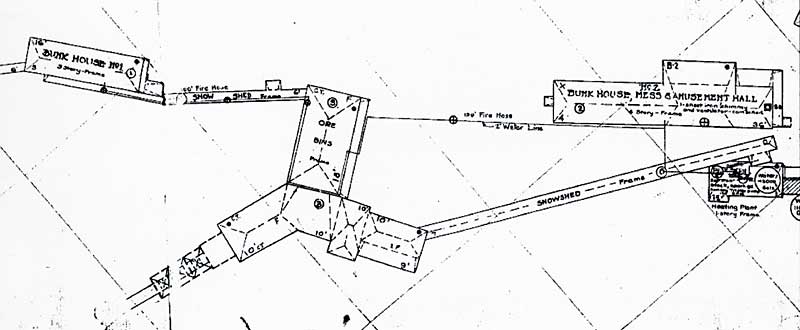 |
| Bonanza Mine upper camp site plan-1926 |
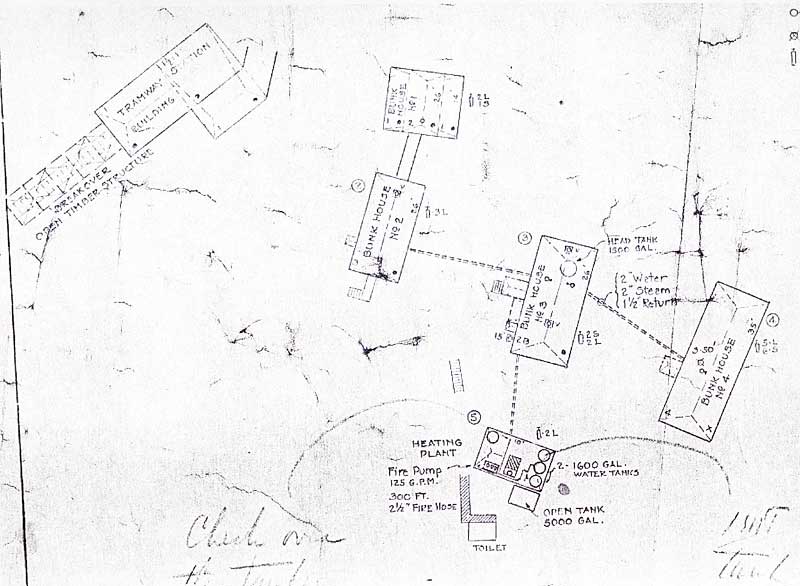 |
| Jumbo Mine upper camp site plan-1926 |
“Frank, these two drawings are ready to be run through the blue print machine. Since you just walked in, I’ll leave it to you.” He smiled at Frank and walked back to his upper-level office. Frank carefully examined the Jumbo drawing. He’d done the surveying for that one himself. Everything in the engineering office was a cooperative effort. The surface drawing looked very good. The map showed four barracks. Frank thought it odd that the drawing had come out so late. This map showed Jumbo as it had been since 1918 when the last of those buildings was erected. Now only two of the four barracks shown was still in use.
This is really a historic document. We don’t use half of what’s shown here. Won’t be long before none of it will be in use. If we ever need the use of a large camp facility again, we certainly have a good candidate up there. I’ll bet we could house 150 men there, if we had to. Right now, it’s more like a ghost camp.
The sun was shining brightly over the glacier. A gleam reflected back from an exposed piece of blue ice on the glacier, catching Frank’s eye. It was so bright that he had to turn his head away. Frank turned toward the other set of windows which looked up the hill, straight into the three-story white-painted staff house where he lived. The windows, framed in dark green trim, stared blankly back at him. At night it was home to eight engineers, two nurses, three teachers and the stenographer. They spent many hours up there playing cards together in one of the two comfortable sitting rooms, listening to the player piano or the Victrola, and otherwise just enjoying each others’ company. But at the moment no one was in there. Everyone was busy at work.
Someday that staff house will be as empty as it looks right now. No one will live there. I can imagine the wind blowing through broken glass and open doors. No other sounds. Just the wind. The whole camp will be empty and open to the elements.
This place is our life. It’s certainly my life. I’m a part of what this is. Kennecott isn’t just a place. It’s us. We’ll all be forgotten if Kennecott is lost. Once these buildings start to go, it will be like none of us ever existed.
Cars of ore at Kennecott, circa 1918 -W.C. Douglass Continue with Ch 44, "Kennecott Goes into Subtle Decline" |
Subscribe to:
Posts (Atom)

